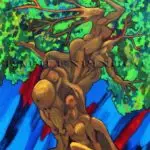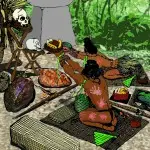CHamoru/Chamorro Ancestor Worship



Table of Contents
Share This
Veneration and respect for the dead
Ancient CHamorus/Chamorros, as well as CHamorus today, practice ancestral worship, or the veneration and respectful treatment of relatives who have died in hopes that they may gain protection or bring you good fortune.
Ancient CHamorus believed in inafa’maolek or the maintaining of harmonious relationships between themselves and their relatives and other neighbors in a village. This belief extended to the world of spirits as well. Just as a family was maintained and fortunes built through cooperation among the living, the centrality of ancestral worship to CHamorus, makes clear that they also believed that their lives would be built and lived, just as much through cooperation and respectful relationships with their deceased ancestors.
Spirits all around
When CHamorus were asked by the Spanish who had made their world, or what Gods had created them, they responded that there were no Gods and simply, that they had made the world. For the Spanish, who believed in a singular all-powerful and all knowing God, this seemed silly. But for Ancient CHamorus who believed that the world around them was full of the spirits of their ancestors tracing back to the CHamoru creation story of Fu’una and Puntan, it was truly them, namely Ancient CHamorus and their ancestral spirits, that had built this world together, and continued to build it each day as mangualo’ (they farmed)’, manpeska (they fished), manggånta (they sang), mañalek (they laughed), mangera (they waged war), ma poksai familia (they raised families).
When a person died, Ancient CHamorus didn’t believe that the aniti (spirit) of the person died or went to a wholly different world. Instead they believed that a person’s soul was taifinakpo’ (without end) and that the anite would return to the world its family still lived in, but with new powers and obligations.
There are two terms which are used today to refer to these ancestral spirits, as well as the spirits of the Ancient CHamoru world in general; manganita (spirits) and taotaomo’na (the before people). Because of the influence of Spanish Catholicism and its denigration and attempted eradication of the indigenous religion of CHamorus, these terms have become loaded for many with negative or “evil” meanings. For Ancient CHamorus these terms were full of respect, reverence and perhaps even fear, but today they most often translate into simply “ghosts” or “devils,” and have lost most of their ancestral worship aspect. Today manganita means evil spirit in CHamoru.
Because of this ancient belief that spirits of ancestors remained in the world, CHamorus worked tirelessly after the death of a relative to ensure that the recently deceased knew it was maguaiya (loved) and marespeta (respected), so that the spirit would return to the homes of its relatives and help protect them from other spirits and bring them prosperity. Shortly after a person died, the body would be laid in the home, with the family surrounding it and a basket placed near its head. The gathered family members would then invite the spirit of the deceased to not leave the family, not go anywhere else, but rather to stay with the family and live in the basket if it wanted to.
Similarly, some families would, after anointing the body with coconut oil, take the body of the deceased to the home of different members of the clan, and at each home ask the spirit if they would prefer to stay here. Later the body would be buried near the home or in a cave. After a certain amount of time had passed, and the flesh had rotted away from the head, the skull would be taken from the corpse and placed in the rafters of the family’s home.
The ancestral skulls, which were called maranan uchan, would be kept in each CHamoru family’s home were protected as sacred objects, not to be touched by outsiders and were often treated almost as if they were members of the family. In general, the skulls were to be spoken to in soft and reverent tones, especially around those who were not family. They were offered food and drink before every meal and regularly thanked for bringing good fortune and prosperity to the clan and home.
Funerals, depending upon the social rank of the deceased, could last for up to 10 days and involve hundreds to thousands of people. The events were meant to prove to the recently deceased that they were loved and revered in life, and that little had changed in death. Different rituals of singing, kulo’ (conch shell) blowing, recitations of family lineage, as well as the destruction by fire of houses, sails, coconut trees and canoes were all done to ensure that the dead knew that they were irreplaceable and their loss incredible painful.
Those who died gained power as spirits and were thought to have power over the natural world and the course of events. If the spirits of one’s ancestors were happy and felt respected then they could assist their descendants in winning battles, performing superlatively in public competitions, and enjoying great successes in fishing and farming. A person could also be punished by their own ancestral spirits. If someone did not fulfill their obligations to the family or caused it to lose much respect by being taimamåhlao (without shame), it was common for spirits to withdraw their protection from that person, which usually resulted in a violent or awful death.
With the world full of spirits from all different villages and families, a clan’s particular ancestral spirits would be needed to protect the clan from the vengeance of its enemies and their own spirits. The spirits of a clan tended to haunt and defend the homes of their descendants. Living people unfamiliar to these spirits would need to ask for permission before entering this territory, or risk being made malångu (sick) or unlucky.
For further reading
Cunningham, Lawrence J. Ancient Chamorro Society. Honolulu: Bess Press, 1992.
Driver, Marjorie G. The Account of Fray Juan Pobre’s Residence in the Marianas, 1602. MARC Miscellaneous Series No. 8. Mangilao: Micronesian Area Research Center, University of Guam, 1993.
Freycinet, Louis Claude Desaulses de. An Account of the Corvette L’Uraine’s Sojourn at the Mariana Islands, 1819. Translated by Glynn Barratt. Saipan: Commonwealth of the Northern Mariana Islands Division of Historic Preservation, 2003.
Russell, Scott. Tiempon I Manmofo’na: Ancient Chamorro Culture and History of the Northern Mariana Islands. Saipan: Commonwealth of the Northern Mariana Islands Division of Historic Preservation, 1998.
Souder-Jaffery, Laura Marie Torres. Daughters of the Island: Contemporary Chamorro Women Organizers on Guam. 2nd edition. MARC Monograph Series No. 1. Mangilao: Micronesian Area Research Center, University of Guam, 1992.
Thompson, Laura M. Guam and Its People. With a Village Journal by Jesus C. Barcinas. 3rd ed. New Jersey: Princeton University Press, 1947.
Topping, Donald M., Pedro M. Ogo, and Bernardita C. Dungca. Chamorro-English Dictionary. Honolulu: University of Hawai’i Press, 1975.
